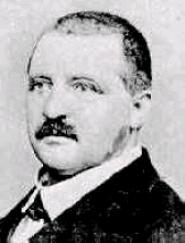Related Research Articles

Malcolm Benjamin Graham Christopher Williamson, AO, CBE was an Australian composer. He was the Master of the Queen's Music from 1975 until his death.

Symphony No. 6 in A minor by Gustav Mahler is a symphony in four movements, composed in 1903 and 1904. Mahler conducted the work's first performance at the Saalbau concert hall in Essen on May 27, 1906. It is sometimes referred to by the nickname Tragische ("Tragic"). Mahler composed the symphony at what was apparently an exceptionally happy time in his life, as he had married Alma Schindler in 1902, and during the course of the work's composition his second daughter was born. This contrasts with the tragic, even nihilistic, ending of No. 6. Both Alban Berg and Anton Webern praised the work when they first heard it. Berg expressed his opinion of the stature of this symphony in a 1908 letter to Webern:
"Es gibt doch nur eine VI. trotz der Pastorale."

The Symphony No. 1 in E minor, Op. 39, by Jean Sibelius is a symphony started in 1898, and finished in early 1899, when Sibelius was 33. The work was first performed on 26 April 1899 by the Helsinki Philharmonic Orchestra, conducted by the composer, in an original version which has not survived. After the premiere, Sibelius made some revisions, resulting in the version performed today. The revised version was completed in the spring and summer of 1900, and was first performed in Berlin by the Helsinki Philharmonic, conducted by Robert Kajanus on 1 July 1900.

Asger Hamerik (Hammerich), was a Danish composer of classical music.
Piano Concerto No. 4 in C minor, Op. 44 by Camille Saint-Saëns, is the composer's most structurally innovative piano concerto. In one sense it is structured like a four-movement symphony, but these are grouped in pairs. That is, the piece is divided into two parts, each of which combines two main movements. However, in each part there is a bridge-like transitional section, between the two main "movements" – for example, a fugal Andante in part II functions as an interlude between the two main triple-meter sections.
- Allegro moderato – Andante
- Allegro vivace – Andante – Allegro

Anton Bruckner's Symphony in F minor, WAB 99, was written in 1863, at the end of his study period in form and orchestration by Otto Kitzler.

Felix Mendelssohn's Octet in E-flat major, Op. 20, was composed in the autumn of 1825 and completed on October 15, when the composer was 16. He wrote the octet as a birthday gift for his friend and violin teacher Eduard Ritz; it was slightly revised in 1832 before the first public performance on 30 January 1836 at the Leipzig Gewandhaus. Conrad Wilson summarizes much of its reception ever since: "Its youthful verve, brilliance and perfection make it one of the miracles of nineteenth-century music."
The Symphony No. 5 in F major, Op. 76, B. 54, is a classical composition by Czech composer Antonín Dvořák. It was originally published as Symphony No. 3.
An organ concerto is a piece of music, an instrumental concerto for a pipe organ soloist with an orchestra. The form first evolves in the 18th century, when composers including Antonio Vivaldi, Johann Sebastian Bach and George Frideric Handel wrote organ concertos with small orchestras, and with solo parts which rarely call for the organ pedal board. During the Classical period the organ concerto became popular in many places, especially in Bavaria, Austria and Bohemia, reaching a position of being almost an integral part of the church music tradition of jubilus character. From the Romantic era fewer works are known. Finally, there are some 20th- and 21st-century examples, of which the concerto by Francis Poulenc has entered the basic repertoire, and is quite frequently played.
Pyotr Ilyich Tchaikovsky composed his Orchestral Suite No. 3 in G, Op. 55 in 1884, writing it concurrently with his Concert Fantasia in G, Op. 56, for piano and orchestra. The originally intended opening movement of the suite, Contrastes, instead became the closing movement of the fantasia. Both works were also intended initially as more mainstream compositions than they became; the fantasia was intended as a piano concerto, while the suite was conceived as a symphony.
Orchestral Suite No. 1 in D minor is an orchestral suite, Op. 43, written by Pyotr Ilyich Tchaikovsky in 1878 and 1879. It was premiered on December 20, 1879 at a Russian Musical Society concert in Moscow, conducted by Nikolai Rubinstein. The piece is dedicated to Tchaikovsky's patroness, Nadezhda von Meck.
Santiago de Espada is a concert overture by the Australian composer Malcolm Williamson.
The Symphony No. 1 Elevamini is an orchestral work by Australian-born composer Malcolm Williamson.
The Piano Concerto No. 3 is a 32-minute concerto by the Australian-born composer Malcolm Williamson.
The Organ Concerto is an orchestral work by Malcolm Williamson.
Lento for Strings is an orchestral work by the Australian composer Malcolm Williamson.
Felix Mendelssohn wrote thirteen string symphonies between 1821 and 1823, when he was between 12 and 14 years old.. These symphonies were tributes to early Classical symphonies especially by Joseph Haydn, Johann Christian Bach, Carl Philip Emanuel Bach and Wolfgang Amadeus Mozart.
The Symphony in D major, Op. 24, is the only work in this genre by the Bohemian-born composer Jan Václav Voříšek. He wrote it in 1821 at age 30; he died young, at only 34.
Graham Whettam was an English post-romantic composer.
References
- ↑ Malcolm Williamson: A 70th Birthday Tribute (Paul Conway)
- ↑ Malcolm Williamson: A 70th Birthday Tribute (Paul Conway)
- ↑ Malcolm Williamson: A Mischievous Muse (Paul Harris & Anthony Meredith)
- ↑ Malcolm Williamson: A 70th Birthday Tribute (Paul Conway)
- ↑ SIGCD053
- ↑ Harris and Meredith, p.404
- ↑ SIGCD053
- ↑ SIGCD053